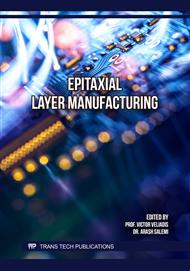p.1
p.9
p.17
p.23
p.33
p.43
p.49
p.57
The 4H-SiC Epitaxy Study of Ammonia Doping
Abstract:
Silicon carbide (SiC) is one of the ideal electronic materials for producing high-temperature, high-frequency, and high-power electronic devices. In the past 20 years, with the continuous improvement of silicon carbide material processing technology, its application have been expanding. Unlike Si devices, SiC devices cannot be directly fabricated on crude wafers. Instead, epitaxial films need to be deposited and grown on SiC wafers, then the epitaxial films will be used to produce devices. The doping concentration performance of the epitaxial layer can determine the device performance, making it the most important indicator of the epitaxial layer quality. For a long time, nitrogen has been used as the dopant in the production of SiC epi-wafers. Due to the difficulty of nitrogen cracking and its adsorption in graphite, the concentration is prone to significant drift, resulting in a decrease in yield and low production efficiency. In this research a vertical epitaxial equipment was used to consecutively grow 10 8-inch SiC substrate with nitrogen and ammonia as dopant separately. The concentration and thickness of the grown epitaxial films were measured and studied. The results indicate that compared to nitrogen as a dopant, the results of ammonia doping are significantly better in terms of intra-wafer concentration uniformity and inter-wafer consistency. Using nitrogen as the dopant, the doping concentrations uniformity of epi-layer ranges from 1.31% to 2.18%, and the deviation is between ± 8.0%. As a comparison, using ammonia as the dopant, the doping concentration uniformity of epi-layer ranges from 0.65% to 0.89%, and the deviation is between ± 1.0%. Meanwhile, the thickness performance is at the same level. Therefore, ammonia as a dopant can solve the concentration drift problem that has long been a headache in large-scale production of SiC epitaxy, greatly improving production efficiency. Its advantages are obvious. This study analyzed the possible reasons for the superior performance of ammonia gas as a dopant for 4H SiC epitaxy compared to nitrogen.
Info:
Periodical:
Pages:
23-31
Citation:
Online since:
September 2025
Authors:
Keywords:
Permissions:
Share:
Citation:


